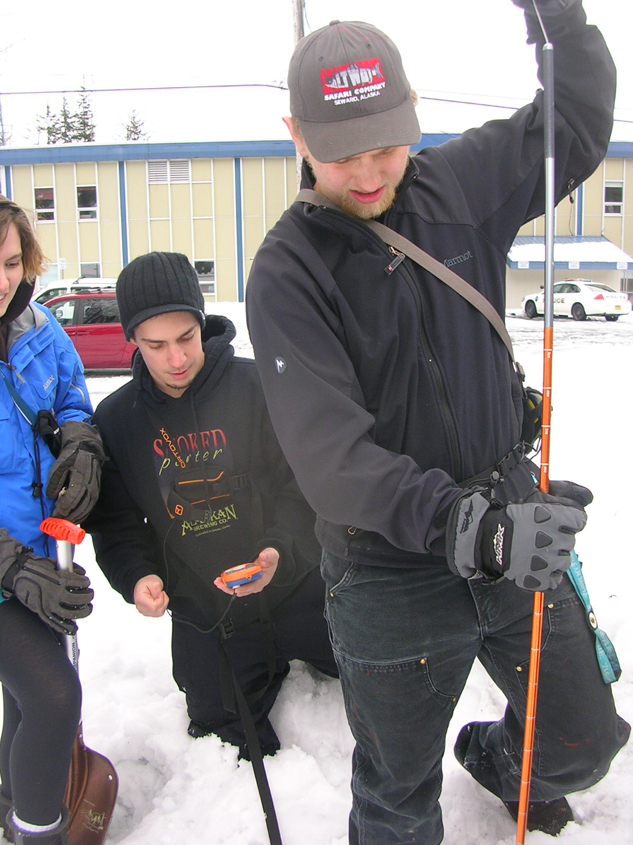Homer may not be nestled in the shadow of a cornice lining the ridge of a snow-covered mountain or — in spite of recent evidence to the contrary — in one of Alaska’s areas of highest snowfalls, but where there’s snow, there’s the risk of avalanches.
Between Jan. 16-18, free “Be Snow Smart” avalanche seminars are being offered in Homer, Kenai and Seward with support from the Alaska Department of Public Safety and taught by professionals of the North America Outdoor Institute. A day of field training will be held in Turnagain Pass with all seminar attendees invited to participate.
Every year on the average, four Alaskans die in avalanches, according to information provided by NAOI. The Colorado Avalanche Information Center reports 34 avalanche-related fatalities in the United States last winter, with three reported for the 2012-2013 season.
“We have snow for so long during the year and have such extreme temperature variations. A lot of people don’t understand that it’s not just what falls from the sky, but what happens with ground conditions,” said Dorothy Adler, NAOI education director who will be teaching the upcoming seminars.
A tragic illustration of Adler’s comments occurred in Homer in March 1990, when two 9-year-olds were playing on the 30-foot incline of a gully near a home off Diamond Ridge Road. A slab avalanche, caused when the bond between layers of snow is too weak to withstand the forces of gravity, occurred. One of the boys was buried in snow to his chest, but managed to free himself and summon help to find his friend, who had disappeared beneath the snow. By the time rescuers found the youngster, he had been under snow for an estimated 45 minutes to an hour. The boy was flown to Providence Hospital in Anchorage and died two days later.
Even roof-shoveling can set off life-threatening avalanches, as reported by the American Avalanche Association. In 2005, a Utah father and son were clearing snow from a cabin roof when the snow slid, swept both men off the roof and buried them under two feet of snow and ice. Rescuers recovered both men within five to 15 minutes.
Poppy Benson, public programs supervisor for the Alaska Maritime National Wildlife Refuge and a Girl Scout leader, is helping spread the word about the upcoming seminar.
“People need to know that there are scary places even on their own property,” said Benson, adding that avalanche-prone areas along the highway sometimes cause concern. “Driving to Anchorage, there have been years when we’ve thought, ‘Do I want to get there this bad?’”
Skier Jan Spurkland, a Kachemak Nordic Ski Club board member, is aware of the risk posed by snowpack layering due to coastal Alaska’s freeze-thaw cycles.
“Now is a good example with early snow and big snowfalls that have been rained upon,” said Spurkland. “ You don’t have to venture very far in backcountry before you find yourself in dangerous terrain.”
Spurkland stressed training like “Be Snow Smart” is “for everybody and anybody that enjoys recreating in the wintertime, whether they’re a motorized or nonmotorized recreational user. Every individual who is out recreating in the wintertime should have avalanche training.”
Phil Needham is a members of Snomads, a local snowmachine and outdoor recreation club, who has trained with the Alaska State Troopers to do search and rescues.
“We go riding up in the Kenai Mountains and across the bay and we try to all have avalanche beacons, probes and shovels,” said Needham.
He encouraged attendance at the avalanche seminar.
“It’s a great opportunity for free training for skiers, snowshoers, snowmachiners,” said Needham. “The big thing about avalanches is that most people think they understand them somewhat, but when they take a class, they’re like, wow, all my common sense stuff was wrong.”
Scott Connelly, Snomads vice president, also stressed the importance of avalanche know-how, especially for young riders new to the activity and the outdoors.
“Any encouragement for young riders to go to this class would be great,” he said.
The “Be Snow Smart” program includes learning and practicing identifying avalanche terrain, snowmobile safety, techniques for avoiding incidents and companion rescue in a worst-case scenario.
“We have something for everyone,” said Adler. “Whether you’re just getting started or a long-time veteran that wants a solid re-refresher, we are here to help.”


